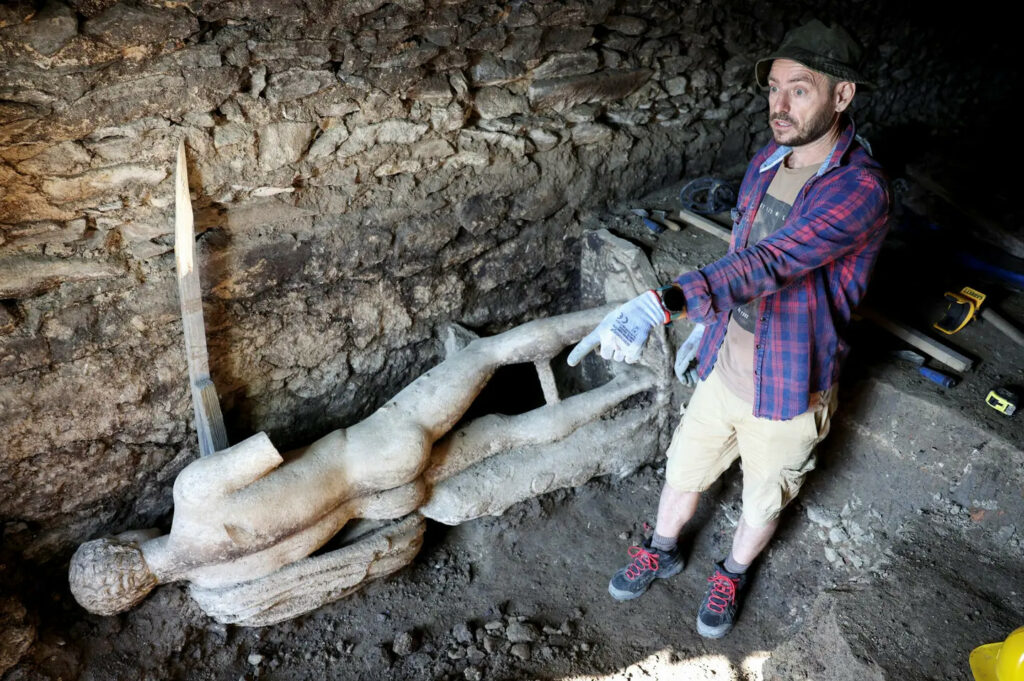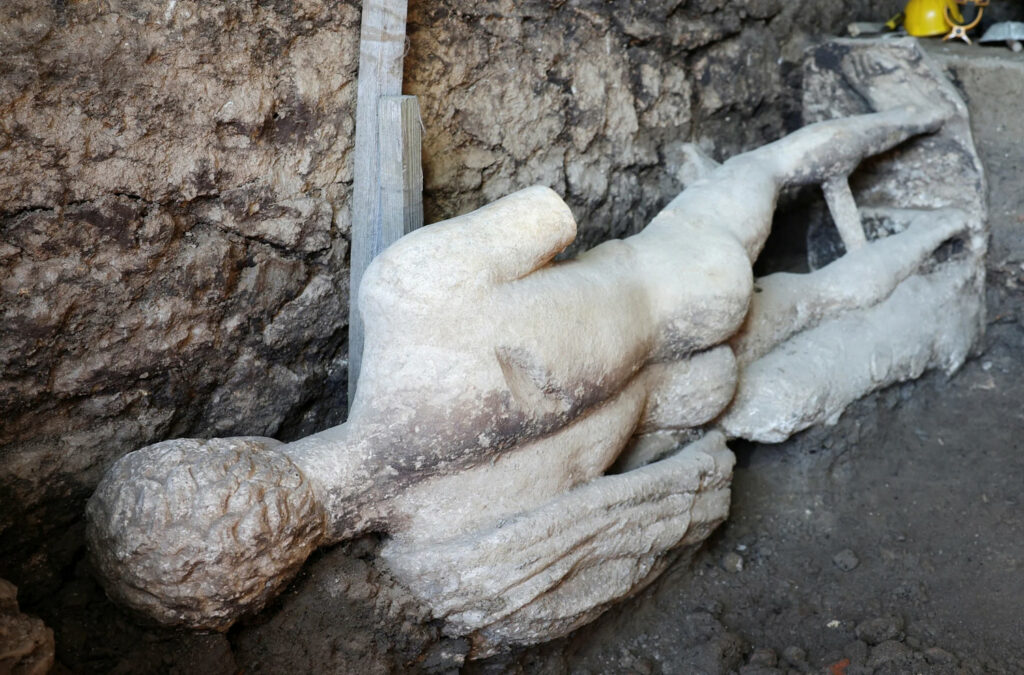Bulgarian archaeologists have made a remarkable discovery in the ancient city of Heraclea Sintica, uncovering a beautifully preserved marble statue of the Greek god Hermes from an unexpected location – an ancient Roman sewer. This extraordinary find has captivated historians and archaeologists alike, shedding new light on the religious and cultural practices of the region during the Roman era.
The 6.8-foot (2-meter) tall statue, discovered during an excavation led by Lyudmil Vagalinski, has survived the centuries in excellent condition, with its head intact and only minor damage to the hands. Experts believe the statue was deliberately placed in the sewer and covered with soil following a catastrophic earthquake around A.D. 388, an act of preservation that suggests the inhabitants of Heraclea Sintica continued to revere their pagan deities even as Christianity became the official religion of the Roman Empire.
In this blog post, we will delve into the significance of this remarkable discovery, exploring the history and cultural context of the ancient Hermes statue, as well as its implications for our understanding of the religious and social landscape of the Roman Empire during this pivotal period.
The Significance of the Hermes Statue

The discovery of the Hermes statue in the ancient Roman sewer of Heraclea Sintica is a remarkable find for several reasons. Firstly, the exceptional condition of the statue is a testament to the care and reverence with which it was treated by the people of the city. Despite being submerged in the sewer, the statue has survived with minimal damage, suggesting that it was intentionally placed there and protected from the elements.
Hermes, the Greek god of trade, travel, and communication, was a central figure in the Greco-Roman pantheon. His statue would have been a prominent and revered symbol in the ancient city, likely standing in a temple or public square. The fact that the statue was carefully preserved and hidden away, even as Christianity was gaining prominence in the Roman Empire, speaks to the continued importance of pagan deities in the lives of the city’s inhabitants.
Moreover, the location of the statue’s discovery is equally intriguing. Typically, one would expect to find such an important artifact in a temple, sanctuary, or other sacred site. The fact that it was found in a sewer suggests that the statue may have been deliberately hidden and protected during a time of crisis or upheaval, perhaps in the wake of the catastrophic earthquake that is believed to have occurred around A.D. 388.
The Historical and Cultural Context

To fully appreciate the significance of the Hermes statue, it is essential to understand the historical and cultural context in which it was created and discovered. Heraclea Sintica was an important city in the Roman province of Thrace, located in what is now modern-day Bulgaria. The city flourished during the Roman era, serving as a hub of trade and commerce due to its strategic location on the Struma River.
During this period, the Greco-Roman pantheon of gods and goddesses remained a central part of the religious and cultural landscape, even as Christianity began to gain a foothold in the empire. The worship of deities like Hermes, Zeus, Aphrodite, and others was deeply ingrained in the daily lives of the people, with temples, shrines, and public statues dedicated to these divine figures.
The discovery of the Hermes statue in Heraclea Sintica provides a fascinating glimpse into the religious and cultural practices of the region during the late Roman era. The fact that the statue was carefully preserved and hidden away suggests that the inhabitants of the city continued to revere their pagan deities, even in the face of the growing Christian influence.
The Implications for Understanding Roman Religion and Culture

The discovery of the Hermes statue in Heraclea Sintica has significant implications for our understanding of the religious and cultural landscape of the Roman Empire during the late 4th century A.D. This period was a time of significant upheaval and transition, as Christianity was becoming the dominant religion and the traditional Greco-Roman pantheon was gradually being supplanted.
The careful preservation and concealment of the Hermes statue suggests that the inhabitants of Heraclea Sintica were actively resisting this religious transition, maintaining their devotion to their pagan deities even as Christianity was gaining prominence. This provides valuable insight into the complex and often contentious relationship between the traditional Greco-Roman religions and the emerging Christian faith during this critical period in history.
Furthermore, the discovery of the statue in an unexpected location, such as an ancient Roman sewer, challenges our assumptions about the role and treatment of these pagan artifacts. Rather than being simply discarded or destroyed, the Hermes statue was clearly seen as a valuable and important object, worthy of being carefully preserved and hidden away for safekeeping.
This discovery also raises intriguing questions about the cultural and social dynamics of Heraclea Sintica during this time. Who were the individuals or groups responsible for the preservation of the Hermes statue? What was the nature of their religious beliefs and practices, and how did they coexist with the growing Christian influence in the region?
Conclusion

The discovery of the ancient Hermes statue in the Roman sewer of Heraclea Sintica is a remarkable and significant find that has the potential to reshape our understanding of the religious and cultural landscape of the late Roman Empire. This beautifully preserved artifact provides a tangible connection to the past, offering a window into the complex and often contested relationship between pagan and Christian beliefs during a pivotal period in history.
As archaeologists and historians continue to study and interpret this remarkable discovery, we can expect to gain new insights into the religious practices, social dynamics, and cultural traditions of the people who once inhabited the ancient city of Heraclea Sintica. This discovery serves as a powerful reminder of the enduring significance of the past and the importance of preserving and understanding our shared cultural heritage.
